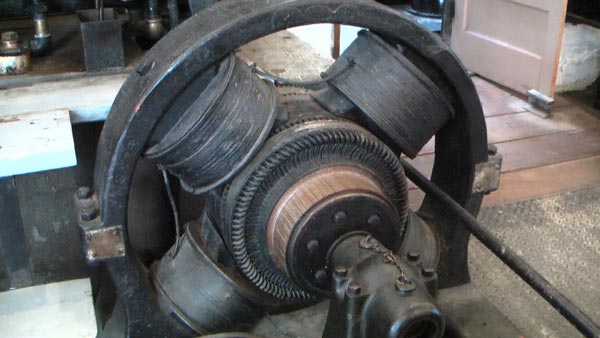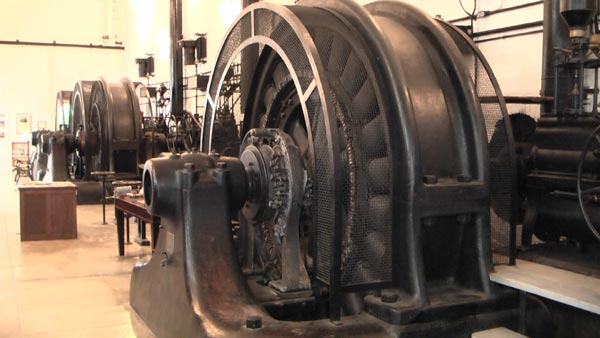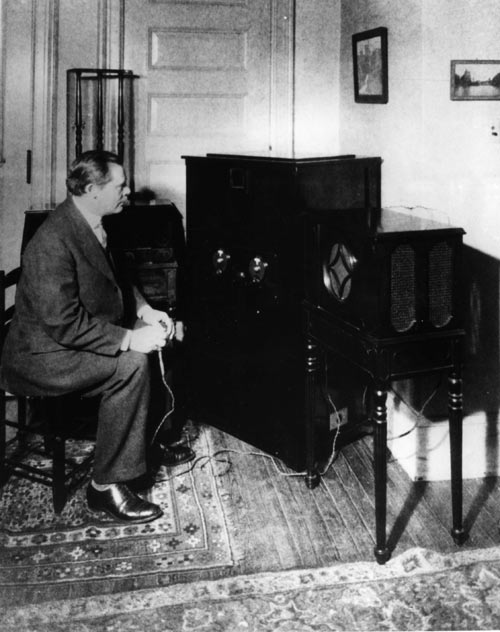
Click on links to learn about each invention if links are listed. ______
Red - Power Generation _____ Grey - communications ____ Light pink - materials or chemistry invention _____ Pink - Superconductivity
Improved Dynamos
1887 and onward Edison established the Edison Machine Works in 1887 on Erie Blvd. in old building 31, they worked improving dynamos there and supplied power to State Street for arc lamps
Better AC Power Generators
1892 - and onward Elihu Thomson and C.P. Steinmetz lead GE's efforts to build the world's largest generators. The first AC generator for industrial use is installed in Colombia Mills, South Carolina. Shortly after came the power stations at Redlands California 1893, Folsom, CA 1896(see photos), and Mechanicville, NY 1897
1896 Elihu Thomson builds electrical equipment for making X-Rays
1900 GE Research Lab is established at the suggestion by C.P Steinmetz. His first concern was to study lighting in response to German competitive advances in incandescent light bulbs.
1896 patent 1903 built 5000 kilowatt steam turbine is designed by Charles Gordon Curtis, he came to Schenectady to sell his idea, GE approved and he built the unit in the downtown plant in 1903, used by Chicago Edison Co.
1914 Charles Curtis patents the gas turbine in the USA, he develops the gas turbine at GE afterwards.
1906 Ernst Alexanderson builts powerful radio wave generators that are used for the first Trans-Atlantic voice broadcast.
1909 William D. Coolidge develops the ductile tungsten filament which makes lightbulbs far more efficient and longer lasting. (This is still used today)
1910 The Hotpoint is the first electric range developed and sold
1912-1950's Irving Langmuir further develops the ideas of Lee De Forest. Langmuir develops many new designs for various uses of the Vacuum tube.
1913 W. D. Coolidge invents a high vacuum x-ray tube with great image resolution and greater output than ever before
1917 Christian Steenstrup develops a sealed refrigeration system which is sold to the consumer as the "monitor top" refrigerator. This technology continues today.
1915 Christian Steenstrup develops a ceramic heating device which is used in stoves, and various home applications
The Magnetron
(the main part of the Microwave Oven)1918 Albert Hull invents the magnetron, used later in radar, microwave ovens, radio transmission, and more...
1918 Ernst Alexanderson develops the 200Kw 25,000 cycle alternator.
1920 Weighing only 20 pounds this system uses an oil-immersed X-ray tube
The Loudspeaker (modern audio speaker)
1921 C. W. Rice and E. W. Kellogg invent the first hornless loudspeaker. It is the first powerful speaker invented and allows talking films possible later on. It is first used in theaters to project sound. In uses the dynamic coil... read more here
1922 WGY reaches audiences as far as South Africa with live radio shows for entertainment. WGY's roots go back earlier, but 1922 was the year the federal government required the station to officially register for a license.
1928 Chester W. Rice develops the use of hydrogen in condensers and turbines. Using hydrogen instead of air inside the devices reduces friction and heat loss.
Television Transmission
1928 Ernst Alexanderson transmits TV on a carrier of WGY to homes in Schenectady.
1930 I 1938 Eugene George Rochow begins the GE Silicone project at the GE Research Lab in 1938. Many products resulted from his work including silicone resins, greases, liquids, and elastomers. A production facility was set up in Waterford, NY in 1947.
1939 nvented by Katharine Burr Blodgett, it is a non-reflective coating which is used on lenses and eyeglasses today
1936 Numerous inventions including the Juice-o-Mat, Hotpoint automatic roaster, and more
1953 Lexan plastic, clear like glass, yet durable enough to stop bullets. It was used for the astronaut bubble helmets.
There are many more!
THIS PAGE IS UNDER CONSTRUCTION We will add more
Engineers from Schenectady were sent down to Oak Ridge to help develop the bomb. Also some personnel were sent from around the country to the Knolls Atomic Power Lab outside of Schenectady. Secret locations in Glenville in rural areas were used for some small experiments and meetings for the Manhattan Project.
1940 WRGB in Schenectady relays tv programs to New York City
1945 Ted Brown and Hal Chestnut develop the fire control computer in the B-29 which allows the machine gun turrets to fire at moving fighter plane targets using radar guidance.
1946 Vincent Schaefer and Irving Langmuir develop cloud seeding (inducing clouds to make rain). This starts more research on atmospheric science.
Project Hermes 1944-1954 and Project Vangaurd develop test missiles using automated guidance and gyro systems.
1950 Robert N. Hall discovers that indium and germanium can be used in P-N Junctions-basic element in power rectifiers and some transistors.
1956 NORYL resine is invented by Allan S. Hay at the GE Research Lab. NORYL is a plastic widely used in engineering that has great strength at high temperatures.
1955
100,000 Gauss1962 The GE magnet team build the world's strongest magnet using superconductors. They use a special wound coil. They achieve a magnetic density of 100,000 gauss (10T) See our video about the story > The GE team consisted of Carl H. Rosner, Charlie Bean, Mark Benz, Garry Morrow, and Howard Hart
1962 Robert N. Hall of the GE research lab invents the semiconductor laser, the main form of laser used in thousands of applications
Carl H. Rosner, Garry Morrow, and Paul Swartz and the Intermagnetics General team invent an MRI that produces a more accurate image. It becomes the standard coil used around the world.
John Heinrich, Garry Morrow, and team at Intermagnetics General produce the world's first mobile MRI unit which is placed in a tractor trailer. This helps several hospitals share the costs of one MRI.
1973 Ivar Giaever of Niskayuna builds a device that proves the existance of Quantum Tunneling. This discovery wins him the Nobel Prize in Physics
GE Capacitor Division led by Oliver H. Winn work with the GE Research lab to develop a capacitor that is 3x more efficient than previously using polypropylene film between foil layers. The product is produced in Hudson Falls and Fort Edward, NY
1982 Dr. Andrew Burke and team develop a computer-controlled hybrid car. This is part of the Joint Feasibiltiy Study of the Hyrbrid Vehicle. When GE cannot sell the car to the big 3 automakers, they sell the technology. Toyota later makes it into a profitable technology.
The hybrid car goes back to the 1916 Owen Magnetic car. In the 1980's computers became powerful and compact enough to be used to control the car's engine and breaking. The computer made it a practical and energy saving invention.
We are currently making a video about this subject, it will be posted at www.YouTube.com/EdisonTechCenter when completed.
Sources for this Information:
Men and Volts - The story of General Electric - John Hammond 1941
General Electric Website
The Life of Steinmetz by Leonard
Workshop of Engineers by Miller
The General Electric Story - A Hall of History Publication
Interview with Robert N. Hall - video by the Edison Tech Center
Interview with Dr. Andy Burke- video by the Edison Tech Center
Interview with Carl H. Rosner- video by the Edison Tech Center
Interview with Dr. Howard Hart- video by the Edison Tech Center
Interview with Paul Swartz- video by the Edison Tech Center
Interview with Garry Morrow- video by the Edison Tech Center
Photo/Video use:
Commercial entities must pay for use of photos/graphics/videos in their web pages/videos/publications
No one commercial or public is allow to alter Edison Tech Center photos/graphics/videos.
Educational Use: Students and teachers may use photos and videos for school. Graphics and photos must retain the Edison Tech Center watermark or captions and remain unmanipulated except for sizing.Permissions - Videos: We do not email, FTP, or send videos/graphics to anyone except in DVD form. Payment is needed for this service. See our donate page for pricing, and our catalogue for a listing of videos on DVD.
Professional video production companies may get videos in data form with signed license agreements and payment at commercial rates.
Copyright 2013 Edison Tech Center



